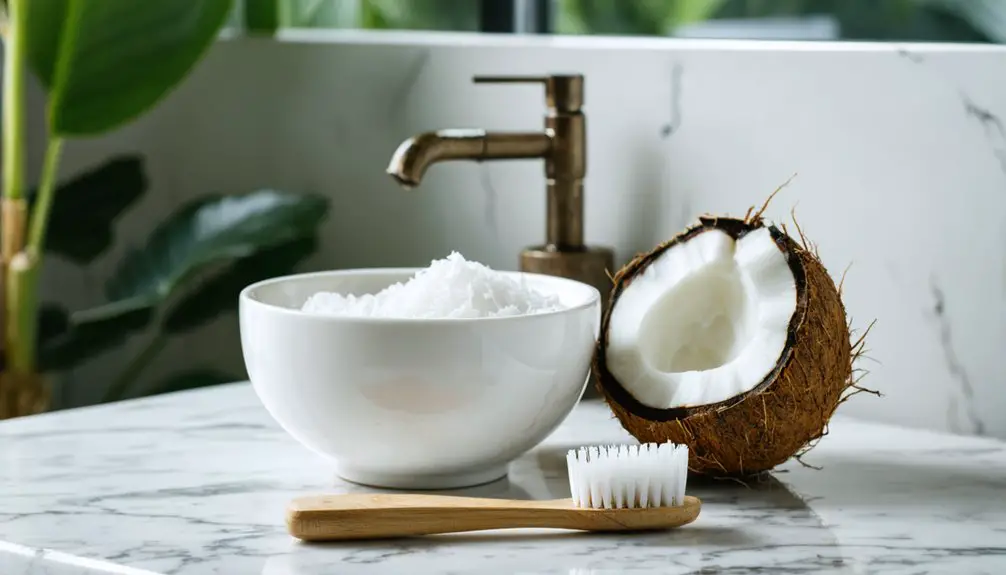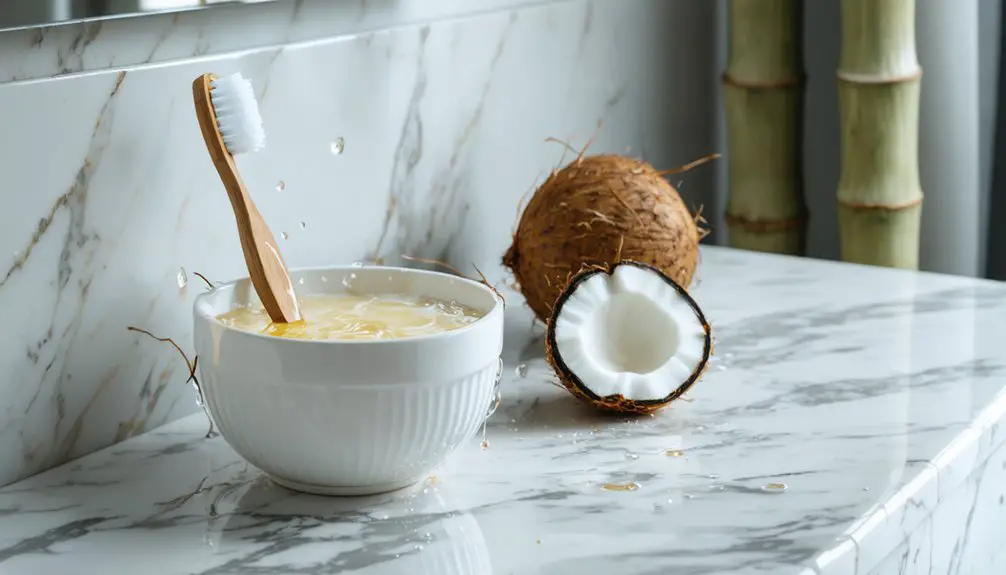To whiten your teeth naturally with coconut oil, start by measuring 1-2 teaspoons of organic, unrefined virgin coconut oil. Warm the oil until liquid, place it in your mouth, and swish gently for 15-20 minutes. Spit the milky mixture into a trash can, not the sink, then rinse thoroughly with water. Perform this process daily on an empty stomach, alongside regular brushing and flossing. While results vary, proper technique and consistency release coconut oil’s full whitening potential.
Key Takeaways
- Use 1-2 teaspoons of high-quality, unrefined virgin coconut oil and warm until liquid if necessary.
- Place oil in mouth and swish gently for 15-20 minutes, breathing through your nose.
- Spit the now milky-colored oil into a trash can, not sink, to avoid plumbing issues.
- Rinse thoroughly with water and follow with regular brushing and flossing routine.
- Perform oil pulling on an empty stomach daily, understanding results require consistent practice and patience.
What Makes Coconut Oil a Natural Teeth Whitener
Five key properties make coconut oil an effective natural teeth whitener. The lauric acid content actively dissolves plaque and bacteria that cause yellowing while strengthening your enamel to prevent discoloration.
The oil’s powerful antimicrobial properties reduce stain-causing bacteria, creating a healthier oral environment that supports natural whitening.
Coconut oil naturally fights bacteria that lead to tooth stains, fostering a cleaner mouth that promotes whiter, healthier teeth.
When you practice oil pulling, coconut oil’s physical action mechanically removes debris and bacteria from tooth surfaces. Through saponification with saliva, coconut oil creates a thin protective film that helps prevent future staining.
You’ll appreciate this natural whitening approach because it’s gentle on sensitive teeth and free from harsh chemicals found in commercial products.
The oil’s protective benefits extend beyond cosmetic improvement – it reduces inflammation, fights bad breath, and maintains long-term oral health.
These coconut oil benefits work together to gradually enhance your teeth’s natural brightness while preserving enamel integrity. Traditional Ayurvedic medicine has recognized the dental health benefits of oil pulling for over 2,500 years.
Scientific Evidence Behind Coconut Oil Pulling
Despite widespread claims about coconut oil’s teeth whitening abilities, clinical studies have found no scientific evidence supporting its effectiveness as a natural whitening agent.
When comparing coconut oil pulling to chemical whiteners in controlled trials, researchers couldn’t demonstrate statistically significant improvements in tooth color or brightness.
You’ll find more scientific support for coconut oil’s modest antimicrobial properties and potential plaque reduction benefits, though these effects are comparable to standard mouthwash rather than professional whitening treatments. The practice originated in ancient Ayurvedic medicine as a traditional oral hygiene technique. Daily oil pulling for 15-20 minutes can be performed as a complementary practice to regular dental hygiene.
Research Findings and Statistics
Recent scientific investigations into coconut oil pulling have produced compelling evidence supporting its potential oral health benefits. A 2016 study of 60 adults showed that daily 10-minute coconut oil pulling markedly reduced harmful Streptococcus mutans bacteria in saliva within two weeks. Starting with fifteen to twenty minutes of daily swishing is recommended for optimal results.
Research has also demonstrated that coconut’s lauric acid provides antibacterial and anti-inflammatory properties that can improve your oral hygiene. The American Dental Association has not officially endorsed oil pulling as a substitute for standard dental care.
While studies indicate coconut benefits include reduced plaque buildup and potential gingivitis prevention, there’s no conclusive evidence for actual tooth whitening effects. Any perceived whitening likely results from plaque removal rather than changes to tooth enamel.
The research shows coconut oil pulling works as effectively as chlorhexidine mouthwash for bacterial reduction, though larger clinical trials are still needed to confirm these findings.
Clinical Studies Show Limited
While many people swear by coconut oil pulling for teeth whitening, scientific research hasn’t yielded strong evidence to support these claims.
Limited clinical studies show that coconut oil pulling produces minimal whitening effects compared to standard treatments like hydrogen peroxide mouthwash, with significant evidence gaps in the research.
The available studies face notable clinical limitations, including small sample sizes and short durations averaging just 14 days.
While some research suggests coconut oil may help reduce tooth staining compared to chlorhexidine, there’s no conclusive proof of actual whitening capabilities. Studies demonstrate hydrogen peroxide mouthwashes consistently outperform oil pulling for tooth whitening results.
Most positive results remain anecdotal, and existing clinical trials lack rigorous controls for factors like brushing habits.
Current scientific evidence indicates that oil pulling’s benefits may stem more from mechanical cleaning action rather than any chemical whitening properties.
Oil vs. Chemical Whiteners
Scientific evidence comparing coconut oil pulling to chemical whiteners reveals significant differences in their mechanisms and effectiveness.
While chemical agents like chlorhexidine actively kill bacteria and bleach teeth through oxidation, coconut oil works primarily through mechanical action and contains lauric acid with mild antimicrobial properties.
You’ll find that many whitening myths surround oil pulling, as research doesn’t support its ability to chemically whiten teeth.
Studies show oil pulling may reduce plaque similarly to chlorhexidine mouthwash, but it doesn’t actually change your tooth color. Instead, what you might notice is temporary stain removal from the swishing action.
Chemical whiteners, however, can cause side effects like mucosal irritation and tooth staining, while coconut oil pulling generally remains safe for most users – though allergic reactions are possible.
Essential Materials and Preparation
To begin your coconut oil teeth whitening journey, you’ll need high-quality unrefined coconut oil, a clean soft-bristled toothbrush, and optional additives like food-grade hydrogen peroxide or essential oils.
You’ll want to gather your materials in a clean workspace and guarantee you have proper storage containers to maintain the efficacy of your whitening mixtures. The mixture should be kept in a brown plastic bottle to preserve potency.
Select coconut oil that contains lauric acid for its natural antimicrobial properties that help fight bacteria in the mouth.
Before each application, you should brush with regular toothpaste first, then measure and mix your ingredients according to the recommended ratios for best results.
Choosing Quality Coconut Oil
Selecting the right coconut oil proves essential for effective teeth whitening results.
You’ll want to choose virgin or extra virgin coconut oil that’s organic and cold-pressed to guarantee superior oil quality. Look for USDA Organic and Non-GMO Project Verified certifications when examining sourcing methods.
The oil’s natural lauric acid content helps eliminate harmful bacteria that cause tooth discoloration.
Check the label for “100% pure coconut oil” without additives or synthetic ingredients. Quality oils should come in dark glass or BPA-free containers to preserve freshness.
Avoid refined or fractionated varieties, as they lack the beneficial properties needed for whitening. The oil should have a mild coconut aroma without any chemical smells.
Only purchase food-grade products from reputable brands with transparent ingredient lists and positive reviews to confirm you’re getting an authentic product suitable for oral care.
Required Tools and Equipment
Three key categories of tools and equipment are necessary for successful coconut oil teeth whitening: basic oral hygiene implements, specialized oil pulling materials, and supplementary whitening aids.
For ideal coconut oil benefits, you’ll need a soft-bristled toothbrush, fluoride toothpaste, dental floss, and a tongue scraper.
Your oil pulling materials should include organic, cold-pressed virgin coconut oil, a measuring spoon, and a clean storage container.
Don’t forget paper towels for cleanup and a dedicated post-pulling toothbrush to prevent cross-contamination.
To enhance your oral hygiene techniques, consider optional aids like baking soda, activated charcoal powder, or LED devices.
Essential accessories include a timer to track the 15-20 minute pulling duration, a garbage receptacle for oil disposal, and alcohol-free mouthwash for final rinsing.
Daily Prep Guidelines
Before beginning your daily coconut oil pulling routine, proper preparation of both materials and workspace guarantees ideal results and safety.
Start by selecting high-quality, unrefined virgin coconut oil and measure 1-2 teaspoons. If the oil is solid, warm it gently using your hands or warm water until it liquefies.
Timing is essential for your oral hygiene practice. Plan to perform oil pulling in the morning on an empty stomach, before brushing your teeth or consuming anything. Make sure you’ve got 15-20 minutes available for the complete process.
Prepare a trash receptacle for disposal, as spitting into sinks can cause plumbing issues. Rinse your mouth lightly with water to remove food particles, and wash your hands thoroughly before handling the oil to maintain proper hygiene standards.
Step-by-Step Oil Pulling Method
To perform coconut oil pulling correctly, you’ll need one tablespoon of high-quality organic virgin coconut oil and ideal timing – preferably first thing in the morning on an empty stomach.
This ancient practice offers numerous coconut oil benefits for your oral health, including reduced bacterial load and improved gum wellness.
Follow these essential steps for maximum effectiveness:
- Place the measured oil in your mouth and allow it to liquefy while maintaining an upright posture.
- Swish slowly and continuously for 15-20 minutes, breathing through your nose while pulling the oil through your teeth.
- Spit the now milky-colored oil into a trash receptacle (never the sink), then rinse thoroughly with water.
Remember to maintain a consistent practice and complement your routine with regular brushing and flossing for best results.
Best Practices for Maximum Results

While achieving ideal results with coconut oil teeth whitening requires attention to detail, following proven best practices will maximize your success.
Begin your oil pulling routine in the morning on an empty stomach, using only organic virgin or extra virgin coconut oil. Maintain a full 15-20 minute swishing duration to guarantee peak contact with teeth surfaces and gums.
Support your enamel strengthening efforts by limiting acidic foods and staining beverages while increasing your intake of calcium-rich foods.
You’ll want to store your coconut oil properly in a cool, dry place and slightly warm it before use.
Remember to complement your whitening regimen with proper dental hygiene – brush gently twice daily, floss regularly, and maintain professional check-ups to monitor your progress.
Common Mistakes to Avoid
Successful coconut oil teeth whitening requires avoiding several critical mistakes that can diminish its effectiveness. Understanding common misconceptions clarified by dental research helps guarantee proper technique and realistic expectations for your oral hygiene routine.
- Don’t mistake surface plaque removal for true whitening – coconut oil primarily removes debris rather than bleaching enamel, so maintain realistic expectations about color changes.
- Avoid excessive swishing durations beyond 20 minutes or multiple daily sessions, as this won’t enhance results and may cause jaw discomfort.
- Never swallow the oil after pulling, as it contains dislodged bacteria and toxins. Dispose of it in the trash rather than the sink to prevent plumbing issues, and always rinse with water afterward.
Remember that coconut oil pulling complements but doesn’t replace regular brushing, flossing, and professional dental care.
Expected Timeline and Results

Understanding realistic timelines for coconut oil teeth whitening helps manage expectations about this natural approach.
You’ll likely need several weeks of consistent daily use before noticing any changes, and the expected results are typically subtle compared to peroxide-based treatments.
Your timeline variability depends on multiple factors, including your swishing duration (5-20 minutes), amount of oil used (1 teaspoon to 1 tablespoon), and individual oral health.
Initial improvements often relate to reduced plaque and cleaner-looking teeth rather than true whitening.
When first using coconut oil pulling, you’ll likely notice less plaque buildup and cleaner teeth before any whitening effects appear.
While coconut oil won’t chemically bleach your teeth, it can help remove surface stains and improve overall oral hygiene.
For best results, use virgin, cold-pressed coconut oil and maintain consistent practice for 4-6 weeks, while continuing your regular brushing and flossing routine.
Combining Oil Pulling With Other Natural Methods
To maximize the benefits of coconut oil pulling, you can safely combine it with several other natural whitening methods. The most effective whitening combinations include using complementary natural substances that work through different mechanisms to enhance your results.
- Mix a small amount of activated charcoal with your coconut oil before pulling to gently remove surface stains while reducing bacteria.
- Follow your oil pulling session with a diluted hydrogen peroxide rinse to chemically break down deeper stains and amplify whitening effects.
- Support your oil pulling benefits by incorporating herbal mouth rinses containing neem or green tea, which provide additional antibacterial properties.
Remember to be cautious with abrasive substances like baking soda and maintain a diet low in staining foods to sustain your whitening results.
Safety Precautions and Considerations

While coconut oil pulling offers potential oral health benefits, you’ll need to follow specific safety protocols to avoid complications and maximize results.
Before starting, verify you don’t have coconut allergies or oral sensitivity issues that could trigger adverse reactions. If you experience any mouth irritation or discomfort, discontinue use immediately.
Use only 1 teaspoon to 1 tablespoon of oil, and avoid swallowing after pulling as it contains harmful bacteria. Always spit the oil into a trash container, not your sink, to prevent plumbing problems.
Start with shorter sessions until you’re comfortable with the technique, and don’t strain your jaw muscles. If you have existing dental conditions or TMJ issues, consult your dentist first.
Remember that oil pulling complements, but doesn’t replace, regular brushing and flossing routines.
Frequently Asked Questions
Can I Do Oil Pulling if I Have Dental Crowns or Fillings?
You can do oil pulling with crowns and fillings, but you’ll need to be extra gentle. Consult your dentist first and avoid aggressive swishing to protect your dental work while gaining oil pulling benefits.
Should I Brush My Teeth Before or After Oil Pulling?
You’ll get better results by brushing after oil pulling, not before. Your post oil pulling care should include thorough brushing to remove loosened debris, while pre oil pulling routine doesn’t require brushing.
Is It Safe to Do Oil Pulling During Pregnancy?
While a million moms worry, you’ll be glad to know oil pulling is generally safe during pregnancy. When done correctly by spitting out the oil, you’ll get oral health benefits without risking fetal safety.
Can Children Practice Coconut Oil Pulling for Teeth Whitening?
You shouldn’t let children practice oil pulling due to serious safety risks including choking and aspiration. While coconut oil benefits oral health, standard dental hygiene remains the safest approach for children’s teeth.
Does the Temperature of Coconut Oil Affect Its Whitening Properties?
While coconut oil melts at 76°F, temperature effects don’t enhance whitening properties. The oil’s consistency only impacts application ease – you’ll get the same results whether it’s solid or liquid.
References
- https://azjd.researchcommons.org/cgi/viewcontent.cgi?article=1301&context=journal
- https://journals.sagepub.com/doi/pdf/10.1177/2229411220160104
- https://pmc.ncbi.nlm.nih.gov/articles/PMC7475120/
- https://www.nature.com/articles/sj.bdj.2018.281
- https://pmc.ncbi.nlm.nih.gov/articles/PMC9602184/
- https://www.antlaradental.com/en/does-coconut-oil-whiten-teeth
- https://www.glenlakedentalcare.com/how-does-coconut-oil-whiten-teeth
- https://www.wattantelopefamilydentist.com/articles/does-oil-pulling-work-for-teeth-whitening
- https://www.medicalnewstoday.com/articles/323757
- https://www.suncreekdental.com/our-practice/blog/does-coconut-oil-whiten-teeth/



